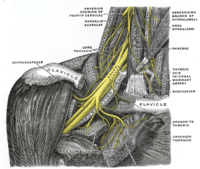
Photo from wikipedia
BACKGROUND Over the course of the past two decades, improved outcomes following brachial plexus reconstruction have been attributed to newer nerve transfer techniques. However, key factors aside from surgical techniques… Click to show full abstract
BACKGROUND Over the course of the past two decades, improved outcomes following brachial plexus reconstruction have been attributed to newer nerve transfer techniques. However, key factors aside from surgical techniques have brought improved consistency to elbow flexion techniques in the latter decade. METHODS 117 patients who underwent brachial plexus reconstruction from 1996 to 2006 were compared with 120 patients from 2007 to 2017. All patients were evaluated preoperatively and postoperatively to assess the recovery time and of elbow flexion strength. RESULTS In the first decade, nerve reconstruction methods included proximal nerve grafting, intercostal nerve transfer, and Oberlin-I transfer. In the second decade, newer methods such as double fascicular transfer and ipsilateral C7 division transfer to the anterior division of upper trunk were introduced. 78.6% of the first decade group versus 87.5% of the second decade group were able to reach M3 flexion strength (p = 0.04), with shorter time recovery to reach M3 in the 2nd decade. 59.8% of the first decade group vs 65.0% of the second decade group were able to reach M4 (p = 0.28), but no significant difference in time of recovery. In both groups, the double fascicular nerve transfer had the highest impact when introduced in the second decade. More precise MRI techniques using the FIESTA view (rootlets), DWI view (ganglion), CUBE and STIR views (trunk and divisions) helped to diagnose the level of injury, the roots involved and evaluate the health of the donor nerves in preparation for intraplexus transfer. CONCLUSION In addition to modified techniques in nerve transfers, 1) MRI assisted evaluation and surgical exploration of the roots with 2) more judicious choice of donor nerves for primary nerve transfer were factors that ensured reliable and outcomes in the second decade.
Journal Title: Journal of reconstructive microsurgery
Year Published: 2023
Link to full text (if available)
Share on Social Media: Sign Up to like & get
recommendations!